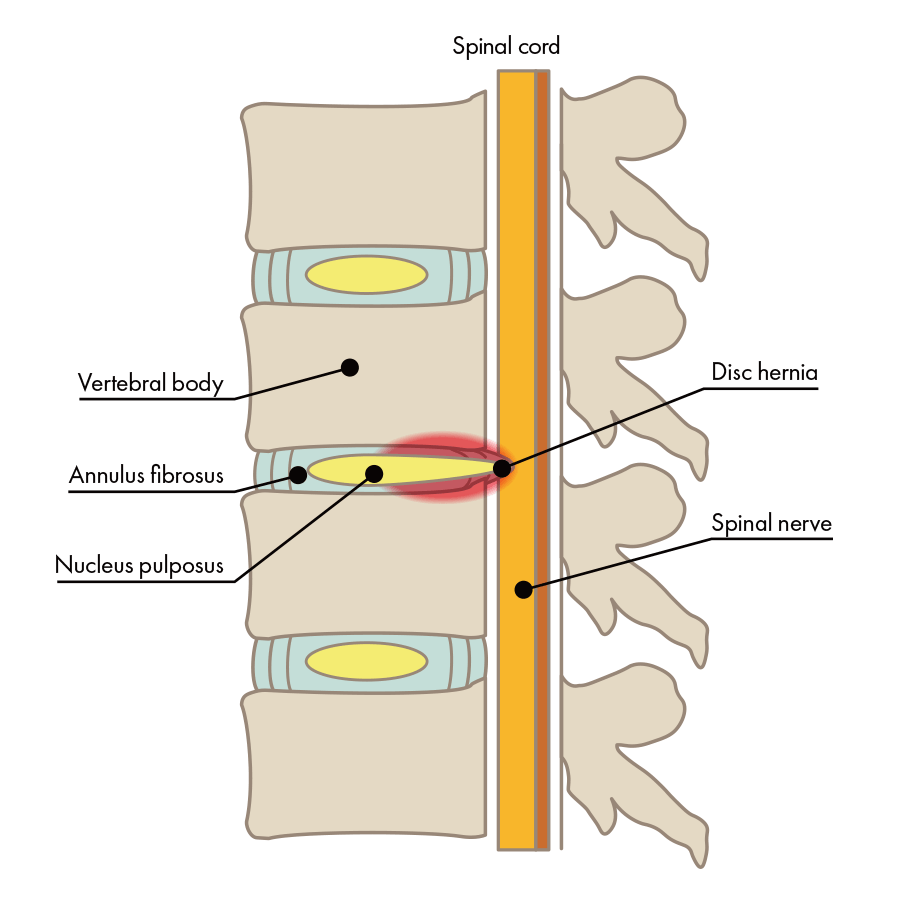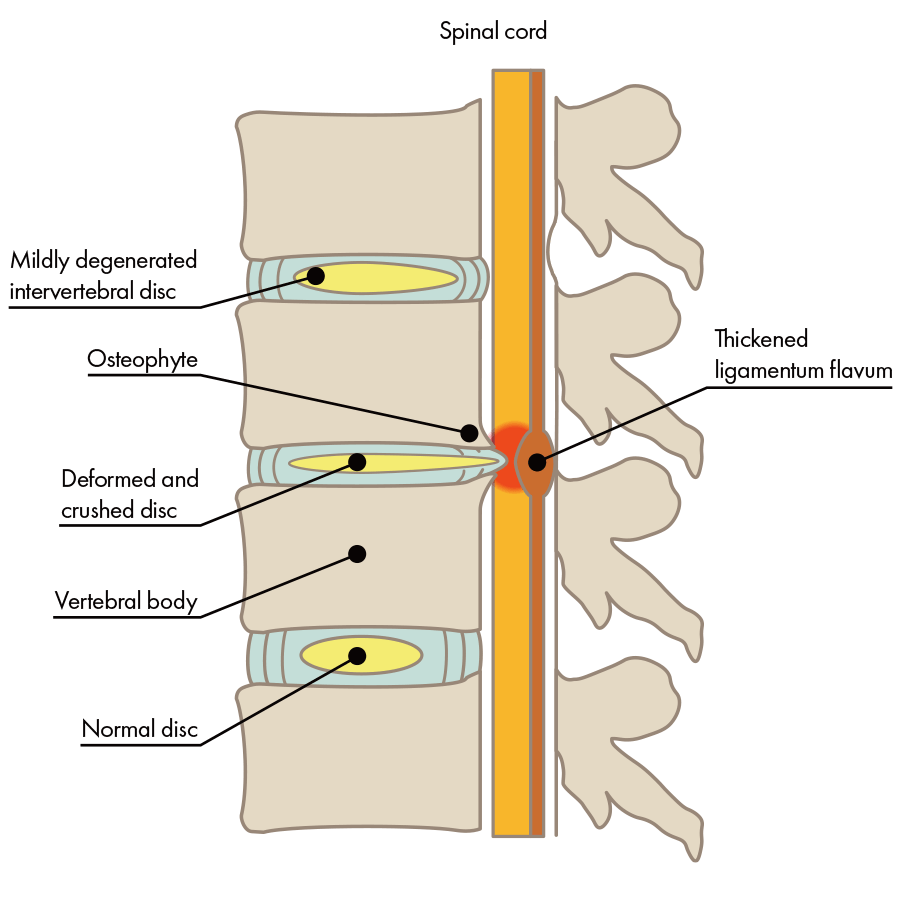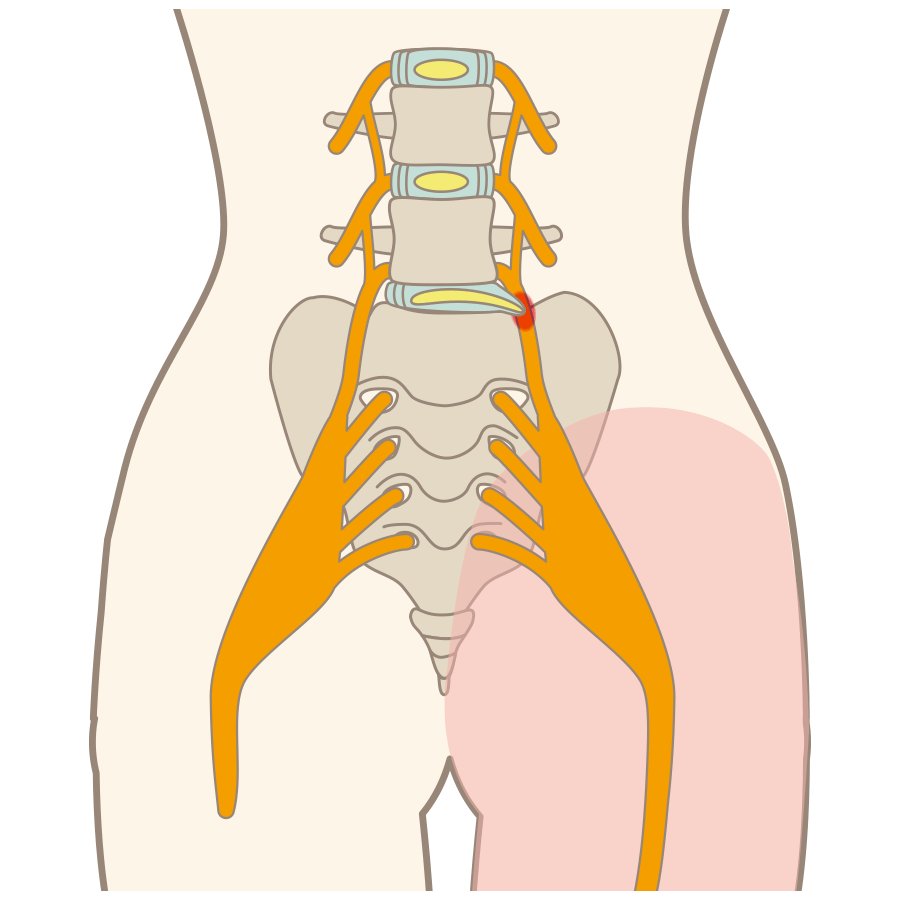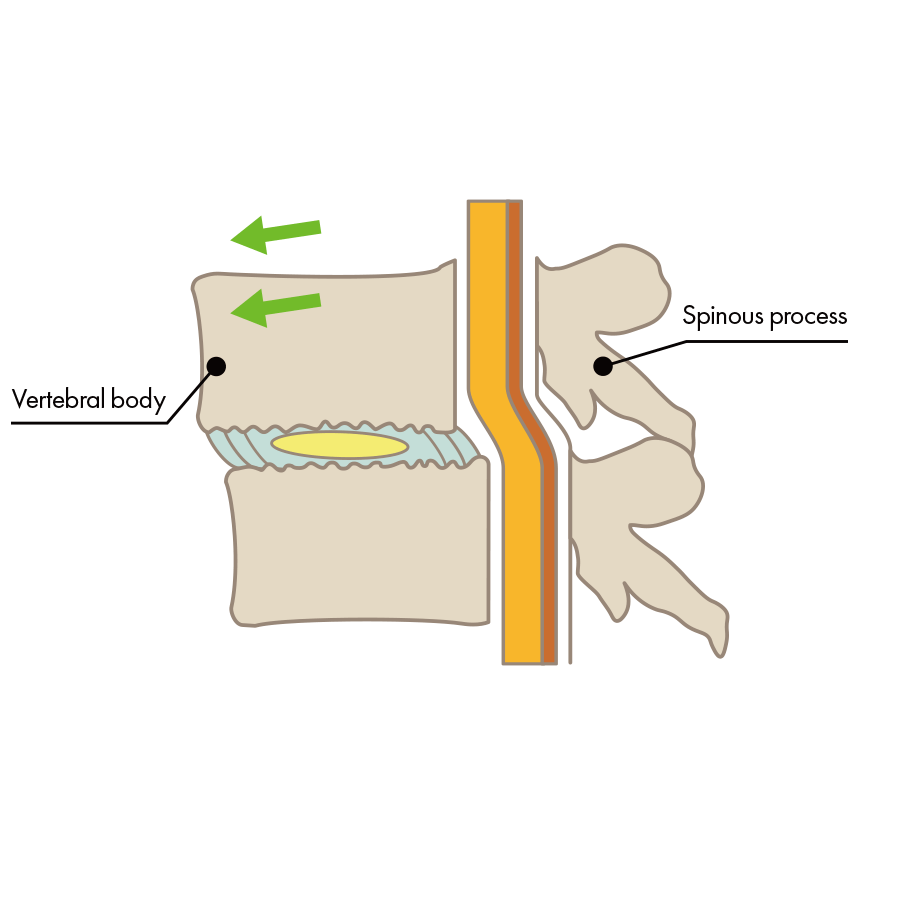Disc Degeneration/ Targeted Conditions
What is intervertebral disc degeneration?
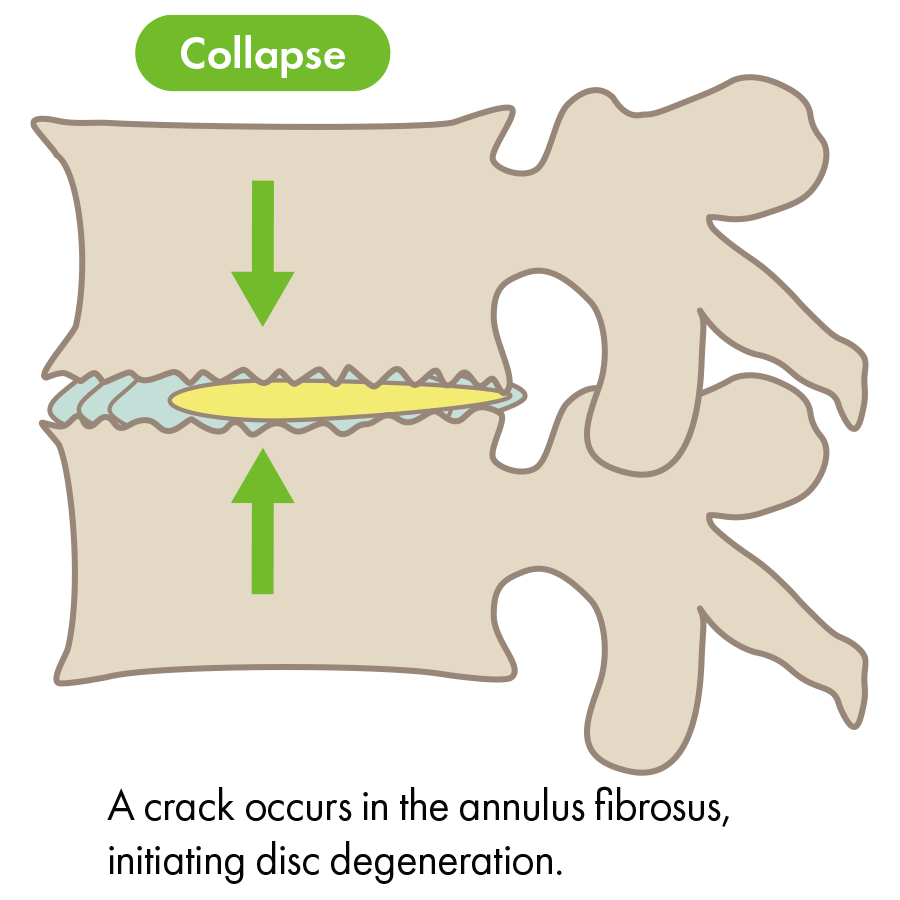
There is a certain area between the lumbar vertebrae (of the spine) that are called "disc degenerations". The disc degenerations have a two-layer structure consisting of an annulus fibrosus and a nucleus pulposus. The annulus fibrosus is made of alternatingly oriented fibers designed to absorb impact from movements in any direction. The nucleus pulposus contains mainly water and its movements help to cushion the disc. What is called disc degeneration degeneration is a condition in which, due to damage or some other cause, the original shape of an disc degeneration can no longer be maintained, initiating deformation of the disc degeneration, and ends up in the deterioration of the disc degeneration function and symptoms such as low back pain.
Causes of disc degeneration
The aging process, excessive physical exercise, work environment, and genetics have all been linked to this condition. Discs are mainly composed of water. As the amount of water in the body decreases with age, it also decreases accordingly in the intervertebral discs. The reduced water content causes the disc to become less flexible and more rigid. When this happens, even the smallest amount of external stimulus can cause the disc to crack. This is one of the causes of disc damage. Also, the disc itself has a limited regenerative ability and has difficulty recovering once damaged. Any physical exercise or work that puts pressure on the disc can cause it to wear out faster and hasten its decline.
Symptoms of disc degeneration

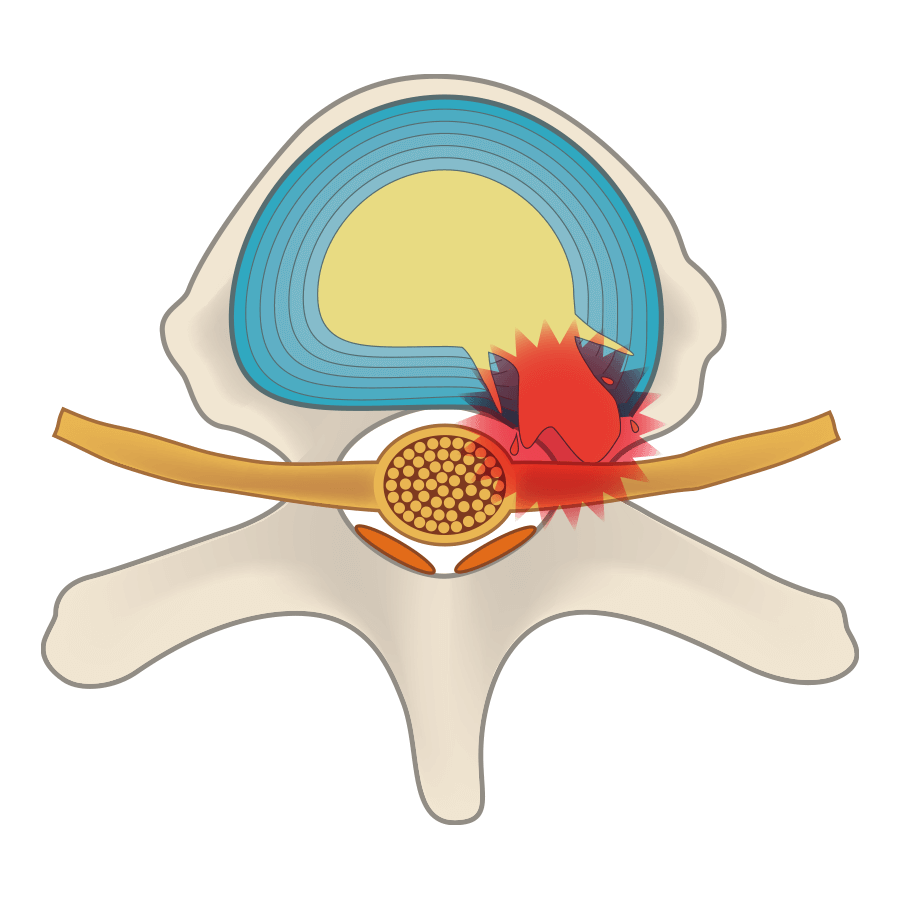
The predominant symptom for an intervertebral disc is lower back pain. A crack in the disc can cause the nucleus pulposus to leak out, resulting in a herniated disc and damage to the nerve. The injury causes nerve inflammation, resulting in symptoms such as pain and numbness in the legs.
*Inflammation is a reaction that occurs when the body is repairing a wound, resulting in pain, swelling and fever.
The deterioration of the discs also reduces their height, shrinking the distance between the bones, so that the discs are more likely to collide into each other. Repeated friction can lead to the formation of bone spurs called osteophytes, or deformity of the vertebral body itself, resulting in degenerative lumbar spondylosis. Due to this deformity, inflammation occurs on the surface of the bone and the surrounding tissues, and in addition to nerve-induced symptoms, new pain occurs in the lower back and around the buttocks.If the inflammation becomes chronic, the body will become hypersensitive because of the pain that has been building up and may not subside even after surgery because it has accumulated for so long.
How to Treat Disc Degeneration
Surgical operation
Surgery may be considered if the nerve is being compressed by the development of bone spurs or caused by a hernia. However, note there are currently no actual surgical procedures that are effective for disc degeneration. This is because the purpose of surgical procedures is to shave bones and ligaments to remove pressure on nerves, and therefore this method offers no actual treatment of the intervertebral disc itself.
Conservative treatments
Our clinic offers physical therapy and medication. Physical therapy is designed to treat the back conditions caused by lifestyle habits, such as standing, walking, and sitting, that have accumulated in the past, remove stress on the body and correct imbalances in muscles and joints to nurse them back to a stress-free state. These corrections are implemented to promote the elimination of inflammation caused by lifestyle-related stress. The lumbar spine also concentrates a large amount of blood vessels, so by improving blood flow, inflammation may be alleviated, and pain reduced.
What treatments at our clinic are effective for disc degeneration?
We offer The Discseel® Procedure at our clinic. The Discseel® Procedure is the injection of medication into the damaged area of the disc to promote disc repair and regeneration. Intervertebral disc treatment is designed to improve pain by restoring disc function and maintaining cushioning. Unlike conventional surgical procedures, this treatment does not involve a scalpel at all, instead a needle is used to directly pierce through the intervertebral disc under local anesthesia, and from there the drug is injected into the disc. This helps restore the original function of the deformed disc and prevents the nucleus pulposus from leaking out by sealing the damaged area of the wound.
Treatment Overview
-
The Discseel
Discseel® Procedure

Discseel® Procedure was developed by an American surgeon by the name of Dr. Kevin Pauza, after caring for hundreds of patients who were made worse following their spine surgery. The treatment aims to seal tears in herniated vertebral discs and help them regenerate and recover their, allowing permanent relief of back pain. Dr. Pauza holds a series of 16 patents for a device and Discseel® biologic that support the treatment. Dr.Nonaka has been licensed to perform the Discseel® Procedure in 2018, and more than 2,880 patient have undergone the treatment in our clinic since then. At present, approximately 20 doctors, including physicians from Harvard and Boston Universities are using the Discseel® Procedure to treat their patients in the USA. Dr. Nonaka is the first physician trained to perform the Discseel® Procedure in Japan.
-
The PODT Method
(Ozone)Percutaneous Ozone Disc
Treatment
PODT is a method that improves low back pain due to discitis or herniated discs or nerve pain due to spinal stenosis by using a 0.8 mm puncture needle to inject ozone into the intervertebral disc’s nucleus pulposus. We cannot say that the particulars of ozone’s anti-inflammatory effect have been elucidated, but it is thought that, by stimulating the inside of the body, ozone treatment intentionally produces a strong immune response and puts an end in a short time to any inflammation that has occurred. The ozone itself is only injected inside the intervertebral disc, but the treatable conditions are not confined to herniated discs: the treatment is also effective for spinal stenosis or vertebral canal stenosis. The reason is believed to be that the ozone injected into the intervertebral disc passes through the damaged disc and permeates surrounding tissue. With the patient under local anesthesia, and while using an X-ray fluoroscope, we safely place a 0.8 mm puncture needle into the intervertebral disc. After that, we inject ozone in proportion to the state of the damage. We finish by checking with the X-ray fluoroscope whether ozone has permeated into and outside of the intervertebral disc.
Disc Degeneration: FAQ
-
- Q
-
What are some precautions to take if I am diagnosed with disc degeneration?
- A
-
First, if the symptoms, such as current pain, are quite severe, try resting and observe your condition for about a week. If the symptoms have improved during the week, conservative treatments, such as exercise, are recommended. If your symptoms do not improve, we recommend a visit to your local orthopedic clinic or hospital.
-
- Q
-
Can a deformed disc ever return to its original state without surgery?
- A
-
If the damage to the disc is minor, it may heal on its own. When the wound closes naturally, the water content inside will increase, and the intervertebral disc will resume fulfilling its original role. However, if the wound is deep and the annulus fibrosus has been torn, it will usually be difficult for it to heal by itself, and if the condition worsens even further, it may lead to a herniated disc or degenerative lumbar spondylosis. In that case, treatment with The Discseel® Procedure may be considered as an option.
-
- Q
-
What is the difference between disc degeneration and a herniated disc?
- A
-
Disc degeneration is a condition where discs crack and become damaged, water escapes from them and the discs start to stiffen, lose their cushioning function and become deformed, leading to lower back pain. At this point, disc herniation occurs when the nucleus pulposus has leaked outside the damaged area and compresses the nerve. The worse disc degeneration gets, the more likely it is that disc herniation will occur.
-
- Q
-
What is some useful advice to bear in mind to prevent disc damage?
- A
-
Disc damage is thought to be caused by aging and other factors, but stress put on the back by postures and movements on a daily basis also plays a great role. Especially, the posture assumed during prolonged sitting puts a lot of strain on the lower back. Therefore, we recommend that you give careful thought to your chair and sitting posture and perform daily training at home.
-
- Q
-
Can I have another surgery if my intervertebral disc becomes deformed again after a first procedure?
- A
-
Spinal canal stenosis will not be completely cured with conservative treatment since it is not a fundamental treatment and can only alleviate the pain and numbness.The Discseel® Procedure is the only treatment which is believed to radically improve symptoms by repairing damaged discs that cause pain and numbness.
-
- Q
-
Are there any exercises that I should not do if I have disc degeneration?
- A
-
Movements that require excessive use of the lower back or holding heavy objects should be avoided. Strenuous exercise can also lead to progressive disc deformity, so make sure you adopt the correct training methods.
Targeted Conditions
-
Disc Herniation

-
Spinal Canal Stenosis

-
Sciatica

-
Spondylolisthesis

-
Disc Degeneration

-
Lumbar Spondylosis

- HOME/
- Targeted Conditions/
- Disc Degeneration



